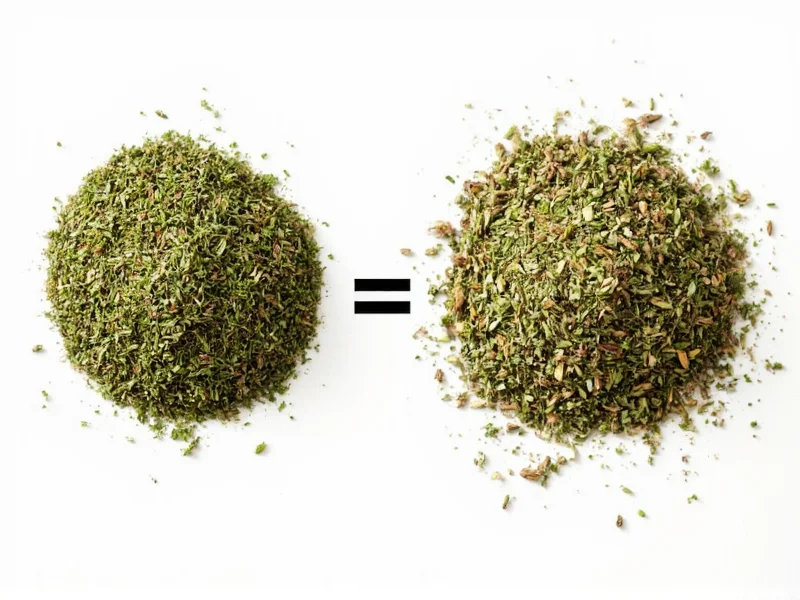Understanding herb conversions is essential for achieving perfect flavor balance in your cooking. While many home chefs assume dried and ground herbs are interchangeable in equal amounts, the reality requires more precision—especially with potent herbs like thyme.
Understanding Thyme Forms: Dried vs. Ground
Dried thyme consists of whole or broken leaves that have been dehydrated, maintaining their leaf structure. Ground thyme takes this process further by pulverizing those dried leaves into a fine powder. This physical transformation significantly impacts both flavor concentration and measurement.
The key difference lies in density. When you grind dried thyme, you eliminate the air spaces between leaves, creating a more compact product. This is why you need less ground thyme to achieve the same flavor intensity as dried thyme—a crucial consideration for how much ground thyme to substitute for dried thyme in your favorite recipes.
Thyme Conversion Chart for Precise Cooking
| Dried Thyme | Ground Thyme Equivalent | Best For |
|---|---|---|
| 1 teaspoon | 3/4 teaspoon | Sauces, stews, braises |
| 1 tablespoon | 2 1/4 teaspoons | Rubbed on meats before roasting |
| 1/4 cup | 3 tablespoons | Large batch cooking or preserving |
Why the 3:4 Ratio Matters in Recipe Development
The dried thyme to ground thyme conversion chart isn't arbitrary—it's based on culinary science. Ground thyme's increased surface area allows for faster flavor release and more immediate integration into dishes. Using equal measurements would result in overpowering thyme flavor that dominates other ingredients.
Chef Marco Rodriguez, culinary instructor at the International Culinary Center, explains: "Ground thyme delivers flavor more aggressively than dried leaves. The 3:4 ratio gives you equivalent flavor impact without overwhelming your dish. This is particularly important in delicate preparations like custards or light broths where herb balance is critical."
Practical Substitution Tips for Home Cooks
When substituting ground thyme for dried thyme in recipes, consider these professional techniques:
- Gradual addition: Add ground thyme in two stages—half at the beginning of cooking and half near the end to preserve volatile flavor compounds
- Moisture activation: Mix ground thyme with a small amount of oil or broth before adding to dry ingredients to prevent clumping
- Taste testing: Always taste after 15 minutes of simmering, as ground thyme's flavor intensifies more quickly than dried leaves
- Recipe adjustment: Reduce other dried herbs by 25% when substituting ground thyme to maintain flavor balance
When to Choose Ground vs. Dried Thyme
Understanding ground thyme vs dried thyme ratio helps determine which form works best for specific applications:
Choose ground thyme when:
- Creating spice rubs that need even distribution
- Preparing sauces where visible herb pieces are undesirable
- Developing marinades that require quick flavor infusion
- Working with time-constrained cooking methods
Choose dried thyme when:
- Preparing slow-cooked dishes like stews or braises
- Creating visually appealing dishes where herb texture matters
- Developing layered flavor profiles through extended cooking
- Working with recipes that specify "crushed" or "whole" dried herbs
Storage Considerations for Maximum Flavor
Proper storage affects your thyme measurement equivalents for cooking over time. Ground thyme loses potency faster than dried leaves due to increased surface area exposed to air.
Store both forms in airtight containers away from light and heat. Dried thyme maintains peak flavor for 1-2 years, while ground thyme should be used within 6-12 months. Older herbs require slight measurement adjustments—increase by 25% for dried thyme over one year old, or 50% for ground thyme over six months old.
Avoiding Common Thyme Measurement Mistakes
Many home cooks make these critical errors when working with thyme conversions:
- Assuming equal volume equals equal flavor: This leads to overpowering dishes when substituting ground for dried
- Not accounting for herb age: Older herbs require measurement adjustments that many recipes don't specify
- Using measuring spoons inconsistently: Always level off ground thyme but lightly pack dried thyme for accurate measurements
- Ignoring recipe context: The same conversion ratio may need adjustment based on cooking time and method
Professional Measurement Technique
For the most accurate measurement conversion for dried thyme to ground thyme, follow this chef-recommended method:
- Use metal measuring spoons (plastic can absorb oils)
- For dried thyme: Gently scoop and level with a knife—don't pack
- For ground thyme: Spoon lightly into measure and level (don't tap or pack)
- When converting: Measure dried thyme first, then calculate ground equivalent
- Always add ground thyme later in cooking than dried thyme











 浙公网安备
33010002000092号
浙公网安备
33010002000092号 浙B2-20120091-4
浙B2-20120091-4